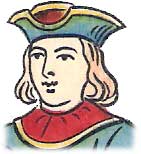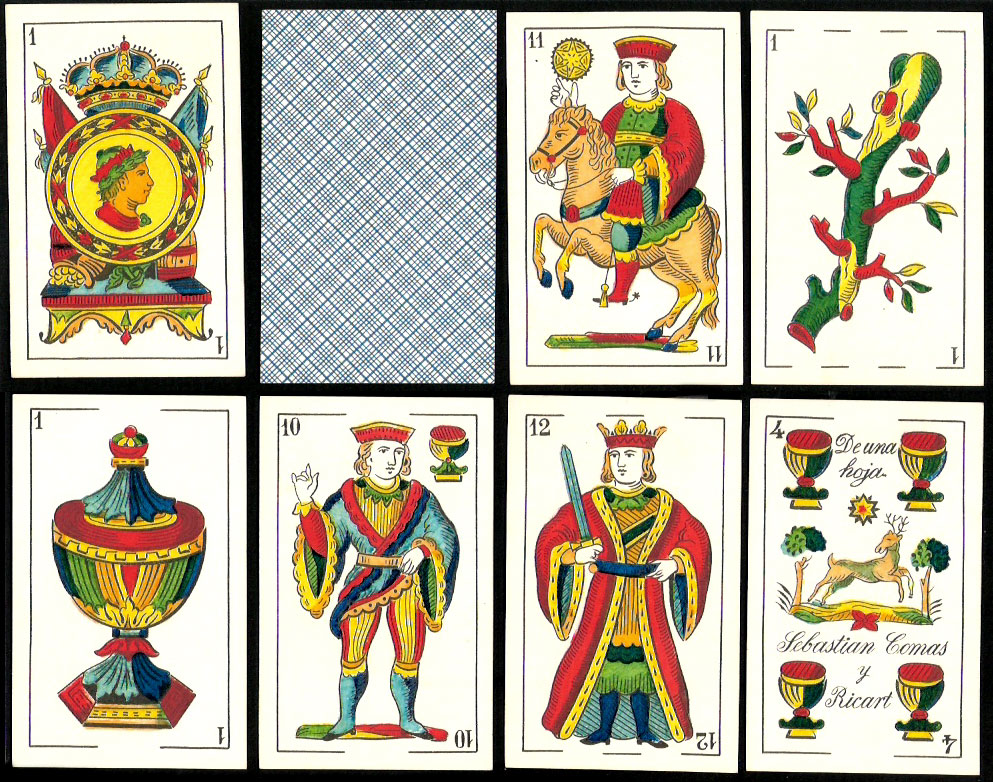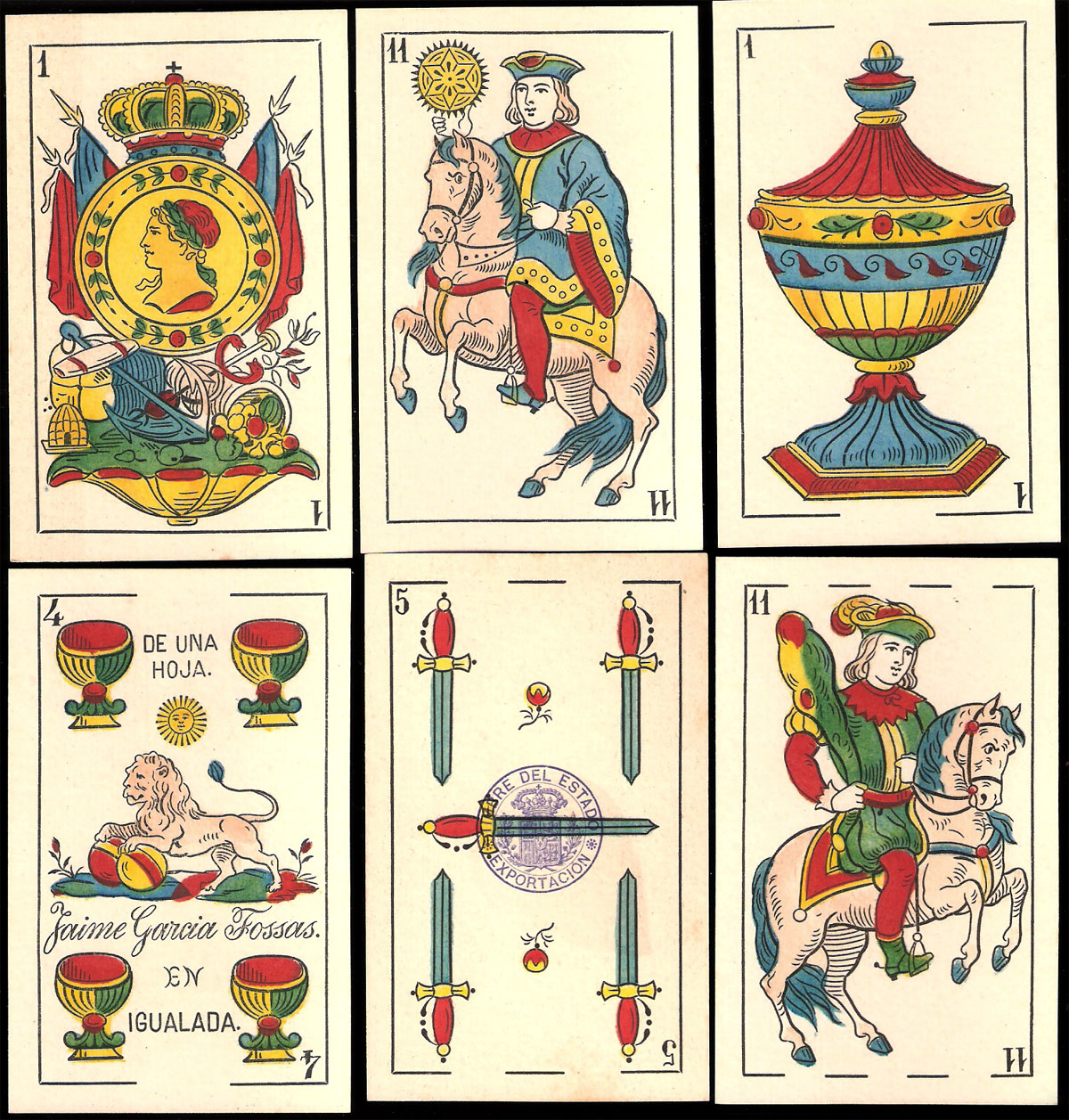Baraja Cartomántica Chocolates Nelia
Some examples of playing cards made in Catalonia from the collection of Iris Mundus, Barcelona.
Some examples of playing cards made in Catalonia from the collection of Iris Mundus, Barcelona.
Spanish advertising playing cards, or trade cards, cover a wide range of popular topics and interests including cinema, bullfighting, boxing and, of course, football. Information was often supplied on the cards about football teams, cinema stars, famous bullfighters or in the case shown (right), fortune-telling interpretations were given. Individual cards might be inserted inside packets of products such as chocolate, or printed on the wrappers or boxes, which could be collected, traded and assembled into full packs.
Baraja Cartomántica Chocolates Nelia
Right: Cartomancy deck published by Camil S.A., printed by Elzeviriana y Librería Camí (Barcelona) in 1932 with fantasy medieval designs. The cards were collected individually from inside packets of Chocolates Nelia. Each card features a divinatory interpretation for upright and reversed readings, provided by Benita la Bruja who sits at the bottom of the card. According to the text on the backs of the cards, Benita la Bruja was a famous card reader who lived in Seville around 1600. 48 large-size cards: 125 x 70 mm. Reference Iris Mundus 1194b.
Note: Iris Mundus was founded in Barcelona in 1965 by Neus Serrano and her husband Salvador Tena in order to pursue their passion for antiques.
• Biblioteca Digital Hispánica: Baraja cartomántica Chocolates Nelia, c.1932►
Es una colección de cuarenta y ocho naipes de cartomancia. En el recto de cada carta hay un texto relativo a su significado de Benita la Bruja. En respaldo de cada naipe hay el mismo texto explicativo: "El arte de echar las cartas...". En recto y respaldo aparece impresa la publicidad de los chocolates Nelia.
En la página 2 del libro aparecen los datos del taller: "Imp. Elzeviriana y Lib. Camí. Barna".
La baraja de naipes se acompaña de un libro "El arte de echar las cartas" de 75 p., con una introducción sobre la cartomancia, ejercicios y significado de los naipes españoles.

Two Examples of the Spanish Catalan Pattern
What is known today as the “Modern Spanish Catalan” playing card pattern (to avoid confusion with the French Catalan style) began to emerge with an identity of its own during the early 19th century and became fully developed by the end of the 19th century. It was primarily manufactured by makers in the Barcelona region (Sebastian Comas y Ricart, Wenceslao Guarro, Giráldez, Juan Roura, etc) but is now regarded as a standard pattern throughout Spain and beyond. Packs usually contain 40 or 48 cards.
Right: standard Catalan pattern deck manufactured by Sebastian Comas y Ricart in Barcelona c.1892. The pack is titled ‘El Ciervo’ on account of the image of a deer, or stag, on the four of cups. 48 cards. Reference Iris Mundus 1131a.

Right: standard Catalan pattern deck manufactured by Jaime Garcia Fossas (1854-1927) in Igualada (Barcelona), c.1904. The deck is titled ‘El León’ and the symbols of industry and commerce on the ace of coins include a beehive. The five of swords has the tax stamp. 48 cards. Reference Iris Mundus 1135a.


By Simon Wintle
Member since February 01, 1996
I am the founder of The World of Playing Cards (est. 1996), a website dedicated to the history, artistry and cultural significance of playing cards and tarot. Over the years I have researched various areas of the subject, acquired and traded collections and contributed as a committee member of the IPCS and graphics editor of The Playing-Card journal. Having lived in Chile, England, Wales, and now Spain, these experiences have shaped my work and passion for playing cards. Amongst my achievements is producing a limited-edition replica of a 17th-century English pack using woodblocks and stencils—a labour of love. Today, the World of Playing Cards is a global collaborative project, with my son Adam serving as the technical driving force behind its development. His innovative efforts have helped shape the site into the thriving hub it is today. You are warmly invited to become a contributor and share your enthusiasm.
Related Articles

Tarot de las Coscojas
Historical playing card design, tarot symbolism and an almost psychedelic medieval surrealism.

Tarot de Valverde de la Vera
A series of 24 surrealist engravings by Mexican artist Claudio Favier in which archetypal Tarot alle...

Baraja de Juan Martín Zamorano
Deck inspired by El Pendón de los Zamorano, a military pennant dating from 1501, published by Priego...

Le Journal de Mickey
Perforated sheet of cards with Disney characters issued with the magazine Le Journal de Mickey.

Tarot hiéroglyphique égyptien
The design of the cards draws inspiration from various religious and philosophical traditions merged...

Heráldica Castanyer No. 16
Strange variant of international pattern cards for poker or bridge.

Oracle Rock
Cartomantic set depicting rock and pop stars, designed by La Rata, with a book by Virginie Despentes...

Eki karuta
Japanese fortune-telling cards based on I Ching, with bold, modern designs.

Fantasy Spanish-suited deck
Fantasy Spanish-suited deck by Bertschinger y Codina, Barcelona.

Bertschinger y Codina - Cartes Françaises
French ‘Paris’ pattern made by Bertschinger y Codina, Barcelona, c.1850.

Braulio Fournier
Baraja Nº 1 produced by Braulio Fournier, Burgos, c.1868.

Tarot Actuel 1984
Major arcana to cut out, issued with the French magazine Actuel, using photographic images.

Pirritx eta Porrotx
Happy Families card game from the Spanish Basque Country.

Naipe Vizcaino
‘Naipe Vizcaino’ designed by Javier Urkiri and published by Industrias Gráficas Castuera and the Caj...

Baraja Turística del País Vasco
Basque poker deck of 55 cards published by Fournier with scenic views of the Basque Country.

Catalan pattern by B.P Grimaud
Standard Spanish Catalan pattern deck made in Paris by B.P Grimaud.
Most Popular
Our top articles from the past 28 days










